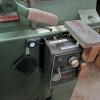I have never waxed my rests. Until recently I have not had no issues with tool rests that i am describing and the last 36 hrs I stopped using wd 40 and mineral oil even longer maybe 4 or 5 days was the last time I used it. I have been sticking to cleaning back of tools with 220, 320, and rest the same 220, 320 seemed to clear most of the gliding issues I have experenced with on the 12" rest but I have a new 9 " rest doing same issue so I been working it the same I think it's getting better all I can think is either some clearer I used or penteration oils are causing this. I was going nuts thinking it was the way I was turning but it is something else.
And do not plan to use wax on my rests.
And do not plan to use wax on my rests.

